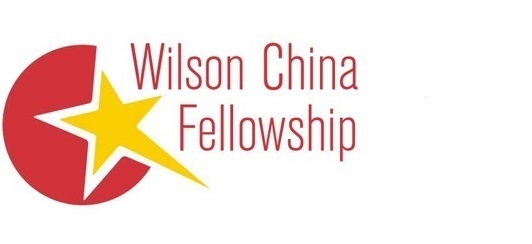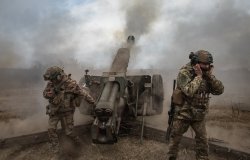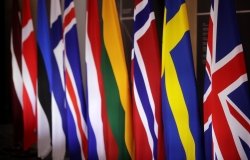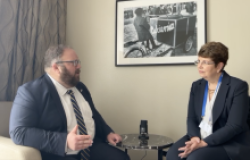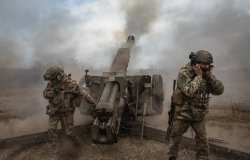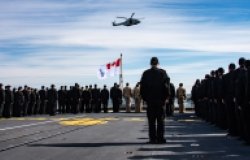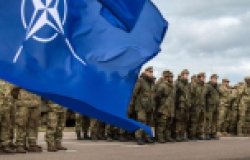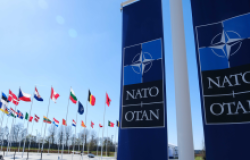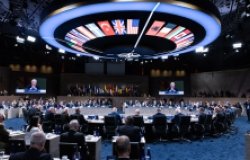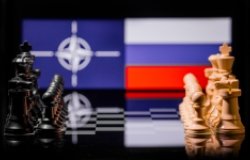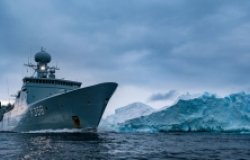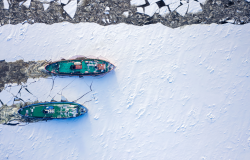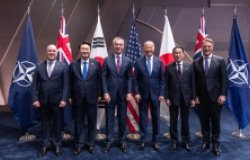NATO’s 75th Anniversary Summit: Standing the Test of Time
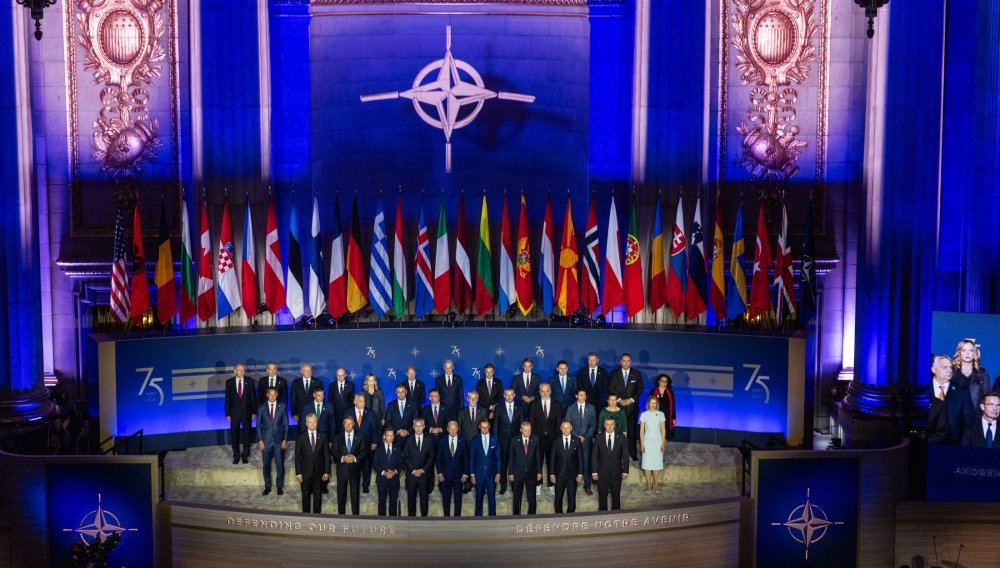
NATO celebrated its 75th anniversary in April and held its annual leaders summit this week in Washington, DC. For 75 years, NATO has provided security and defense to more than one billion people on both sides of the Atlantic. Although the mood this week was largely jubilant, the Washington Summit Declaration showed the convening was more than an opportunity for commemoration, it served as an inflection point for the Alliance’s future and a call to action for maintaining support to Ukraine. Three main topics prevailed and indicate future trends for the Alliance: 1) support to Ukraine, 2) strengthening NATO’s deterrence and defense, 3) deepening partnerships in the Indo-Pacific region. With a new Ally–Sweden–participating for the first time, a renewed purpose and greater unity for the Alliance in light of Russia’s 2022 invasion of Ukraine, at 75 NATO finds itself more indispensable than at any other point in its history.
More than a celebration
First, the Alliance celebrated numerous milestones and achievements. The Washington Summit was the first summit for Sweden as a full NATO Ally after officially joining the Alliance on March 7, 2024. Sweden and Finland’s decision to join NATO was the single greatest consequence of Russia’s invasion of Ukraine in 2022; both are extremely capable Allies that amplify capabilities in Europe’s northern flank and more than double NATO’s border with Russia. Another cause for celebration is that a record 23 of 32 Allies are projected to hit the 2% of GDP threshold for spending. Allies agreed at the Wales Summit in 2014 to meet this minimum but it has been slow to materialize–in 2014 only 3 countries were spending 2% of their GDP. Since February 2022, European defense spending has increased by more than $80 billion overall. The fact that Europeans are spending more for their own defense than ever before and are providing more than the United States in support of Ukraine–a narrative that has been slow to catch on in Washington–was made abundantly clear at the Washington Summit.
The fact that Europeans are spending more for their own defense than ever before and are providing more than the United States in support of Ukraine–a narrative that has been slow to catch on in Washington–was made abundantly clear at the Washington Summit.
The summit celebrated the origins of the Alliance, with President Biden’s speech on Tuesday launching the summit in the very place where the North Atlantic Treaty was originally signed in 1949. A highlight of the summit was the well-deserved praise for NATO’s outgoing Secretary General, Jens Stoltenberg. His mandate has been unanimously extended four times, making him the second longest serving Secretary General in NATO’s history. He has guided the Alliance through a remarkable period of transformation across multiple US administrations, the pandemic, and Russia’s illegal invasion of Ukraine in 2022. This week was as much a celebration of NATO’s anniversary as for Secretary General Stoltenberg’s leadership: President Biden awarded him with the Presidential Medal of Freedom; Secretary Austin bestowed the highest honor for non-US citizens from the Department of Defense; and Secretary General Stoltenberg threw the first pitch for the Washington Nationals baseball team. World leaders and top officials offered praise for his decade of service at every possible opportunity: the NATO Alliance is stronger, more capable, and more united than when he took over the helm in 2014.
NATO responds to current threats and foresees new challenges
Despite these achievements, there is still more to be done. The NATO Summit ironed out multiple deliverables to respond to the most challenging security environment since World War II. The Washington Summit Declaration largely echoed past NATO policy and talking points, with some notable new takeaways.
Since 2022 it has become clear that Europe’s defense industry is not capable of matching Russia’s output. Estonia’s defense minister estimates Russia is spending between 7-9% of its GDP on its military. To that end, NATO announced a new Industrial Capacity Expansion Pledge to strengthen the Alliance’s defense industry, increase large scale and multinational procurement, and enhance supply chain resilience. Building on the Defence Production Action Plan agreed at the Vilnius Summit in 2023, the new pledge also enhances cooperation with NATO partners and Ukraine. The US in turn is doing its part, having invested $30 billion in defense manufacturing to restart or expand production across 35 states. With Russia capable of reconstituting its forces back to pre-2022 levels within 5-7 years, Europe and North America are already behind where they need to be on defense production capabilities to respond to a resurgent Russia.
Russia has been and remains the most significant and direct threat to Allies’ security. The country was again singled out for “shattering peace and security in Europe” when it invaded Ukraine in 2014 and again in 2022. Its malign hybrid activities (in the Baltic Sea region in particular), led Allies to reaffirm in the Washington Summit Declaration this can lead to the triggering of Article 5. In what was perhaps omitted from the final version of the declaration, Poland’s Minister of Foreign Affairs, Radek Sikorski, referred to Russia as a multi-domain threat at the NATO Public Forum. A revanchist Russia remained the main focus of the summit, with little deviation from past NATO policy announced this week.
With Russia capable of reconstituting its forces back to pre-2022 levels within 5-7 years, Europe and North America are already behind where they need to be on defense production capabilities to respond to a resurgent Russia.
One marked difference regarding Russia, in a sign of the times, is that a greater portion of the Washington Summit Declaration focused on Russia’s allies and partners. The Democratic People’s Republic of Korea (DPRK) and Iran were both condemned for fuelling Russia’s war against Ukraine. Perhaps the strongest language was directed at China, which was described as “a decisive enabler of Russia’s war against Ukraine through its so-called “no limits” partnership and its large-scale support for Russia’s defence industrial base.” China was not featured as a concern in official NATO statements prior to 2019, but has increasingly been referred to as a “systemic challenge” to Euro-Atlantic security due to China’s “no-limits” partnership with Russia. The 32-nation Alliance–all of whom had to agree to the language in the declaration– unanimously condemned China’s support of Russia. Although China officially claims to not be selling weapons systems to Russia, it is still providing dual use material, computer chips, components, and advanced software that enables Russia’s war machine. In some of the harshest language in the declaration, the Alliance resoundingly states China “cannot enable the largest war in Europe in recent history without this negatively impacting its interests and reputation.”
China’s increased prominence in NATO statements has led the Alliance to re-evaluate its partnerships in the Indo-Pacific region. Since the 2022 summit in Madrid, the Asia-Pacific 4 (AP4)–Australia, New Zealand, Japan, and South Korea–have been invited to participate in NATO summit discussions. The Washington Summit Declaration makes it clear that the Euro-Atlantic and Indo-Pacific theaters are interlinked, with the security dynamics mutually affecting one another. The AP4 are increasingly selling weapons systems and technology to Europe to replenish depleted reserves, are supporting Ukraine in their own ways, and offering their expertise on cyber defense and countering disinformation. It is increasingly becoming clear that NATO will have a future, if yet defined, role in the Indo-Pacific.
Planning for long-term assistance for Ukraine
Heading into the Summit, Allies and commentators reluctantly adopted the official metaphor of a “bridge” for Ukraine’s entry into NATO. Described at various points throughout the summit by officials as a steel bridge, a bridge with lights, and a short bridge–signifying the resolve, clarity, and brevity of Ukraine’s path to NATO membership–the “bridge” analogy quickly became synonymous with perceived inertia on full membership. However, despite little progress for Ukraine towards full membership, NATO leaders brought unprecedented measures for long-term support for Ukraine at the Washington Summit, outlined in the summit declaration in a standalone section. President Zelensky will not return to Kyiv emptyhanded.
As the NATO Summit began, President Biden pledged to provide Ukraine with five new air defense systems. While this falls short of Zelensky’s request for seven, this is still a major achievement for Ukraine, which sorely needs more air defense capabilities. This followed a brutal attack by Russia on Monday, with missiles striking a children’s hospital and killing more than 40, a grim postcard from Putin as NATO Allies were preparing to meet in Washington. Additionally, an update on the deployment of F-16 fighter jets was provided by the White House, saying the transfer process is underway and the F-16s will be flying this summer. These American-made F-16s have been donated by the Dutch and Danish governments, with Denmark also providing training to Ukrainian fighter pilots. Belgium and Norway have also committed to providing additional aircraft. Before the summit began, Ukraine already had tangible deliverables, buoying spirits and talks.
In a marked shift, for the first time NATO announced in the Washington Summit Declaration it will directly coordinate financial support for Ukraine via the new NATO Security Assistance and Training for Ukraine (NSATU), pledging a minimum baseline funding of €40 billion ($43.3 billion) within the next year. For the last two and a half years, NATO itself has been hesitant to be more directly involved in the conflict over concerns of bringing the Alliance into direct crossfire with Russia. NATO has sought more of an advocacy role but that appears to be changing. NATO will take on a more prominent role in the provision of military equipment, assistance, and training for Ukraine, including purchasing equipment, investments in Ukraine’s defense infrastructure and industry, and covering costs related to maintenance and logistics for military equipment. This is a major step towards making support for Ukraine consistent, efficient, and predictable.
In another positive sign towards Ukraine’s full membership, a swirling question of whether NATO intended to follow through on its promise to move forward with it began to gain momentum in the run-up to the summit. NATO allies made it clear that Ukraine’s path towards NATO membership was “irreversible” and therefore not up for debate in any potential future negotiations with Russia. Although no timeline for membership exists, this was an important symbolic gesture to assure Ukraine about its future in the NATO Alliance.
Ukraine is fighting on behalf of Europe and North America to defend freedom and democracy against Russia and prevent the spread of authoritarianism. NATO is fundamentally good for American security interests, as European security interests are intrinsically linked to US national security. Two World Wars taught Americans this lesson
As the US heads to vote on its next president this fall and world leaders gathered in Washington, there was an emphasis on making the case to the American public over the continued value of NATO. Poland’s Foreign Minister Sikurski directly pointed out at the NATO Public Forum, the US economy benefits greatly from weapons sales to Europe. Ukraine is fighting on behalf of Europe and North America to defend freedom and democracy against Russia and prevent the spread of authoritarianism. NATO is fundamentally good for American security interests, as European security interests are intrinsically linked to US national security. Two World Wars taught Americans this lesson and necessitated the creation of NATO. Then, 12 leaders met in April 1949 in the Mellon Auditorium in Washington with the goal of preventing further war in the Euro-Atlantic area. And in the 75 year history of the Alliance, NATO has by-and-large succeeded in preventing massive interstate war from returning to Europe. As NATO assembled leaders and top officials from its now 32 members–plus partners from the Indo-Pacific, the European Union, and Ukraine– for the 75 year anniversary of the Alliance, NATO has proven to stand the test of time.
About the Author


Global Europe Program
The Global Europe Program is focused on Europe’s capabilities, and how it engages on critical global issues. We investigate European approaches to critical global issues. We examine Europe’s relations with Russia and Eurasia, China and the Indo-Pacific, the Middle East and Africa. Our initiatives include “Ukraine in Europe” – an examination of what it will take to make Ukraine’s European future a reality. But we also examine the role of NATO, the European Union and the OSCE, Europe’s energy security, transatlantic trade disputes, and challenges to democracy. The Global Europe Program’s staff, scholars-in-residence, and Global Fellows participate in seminars, policy study groups, and international conferences to provide analytical recommendations to policy makers and the media. Read more
